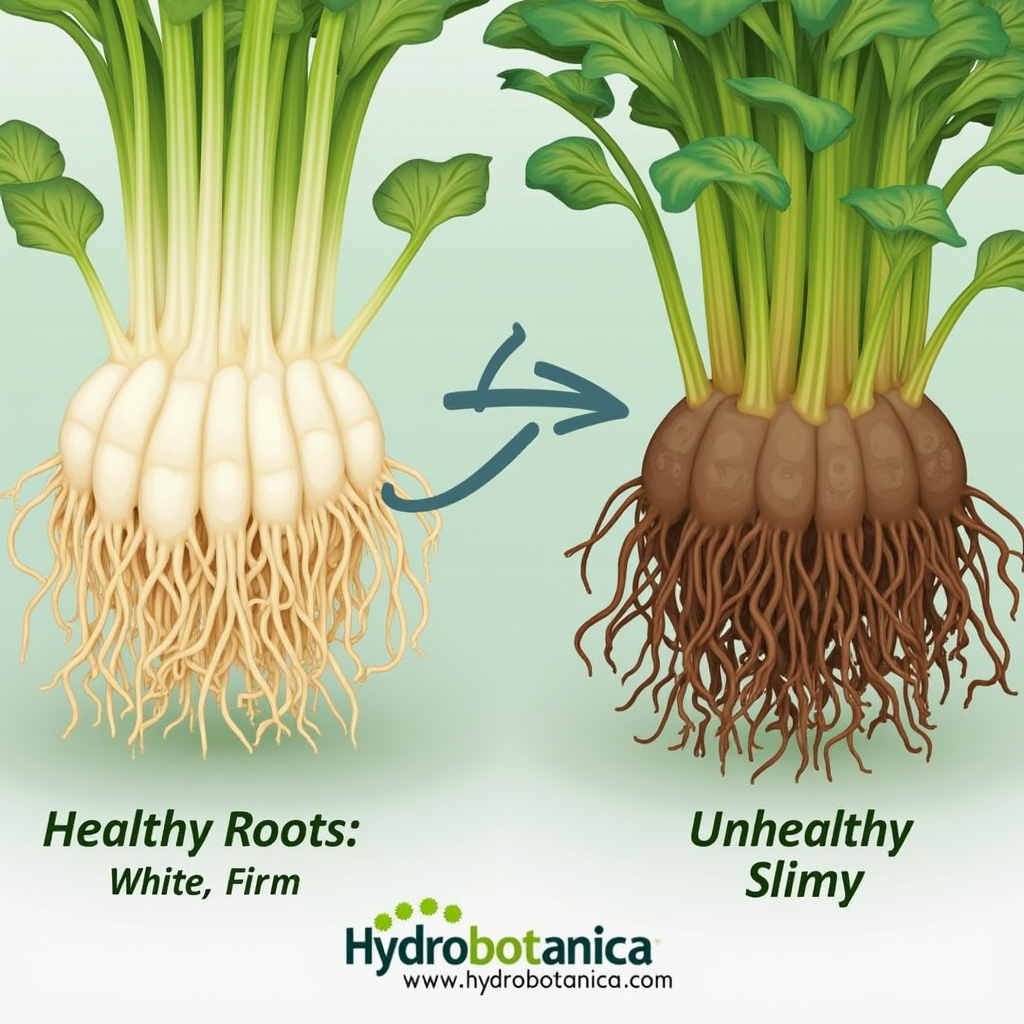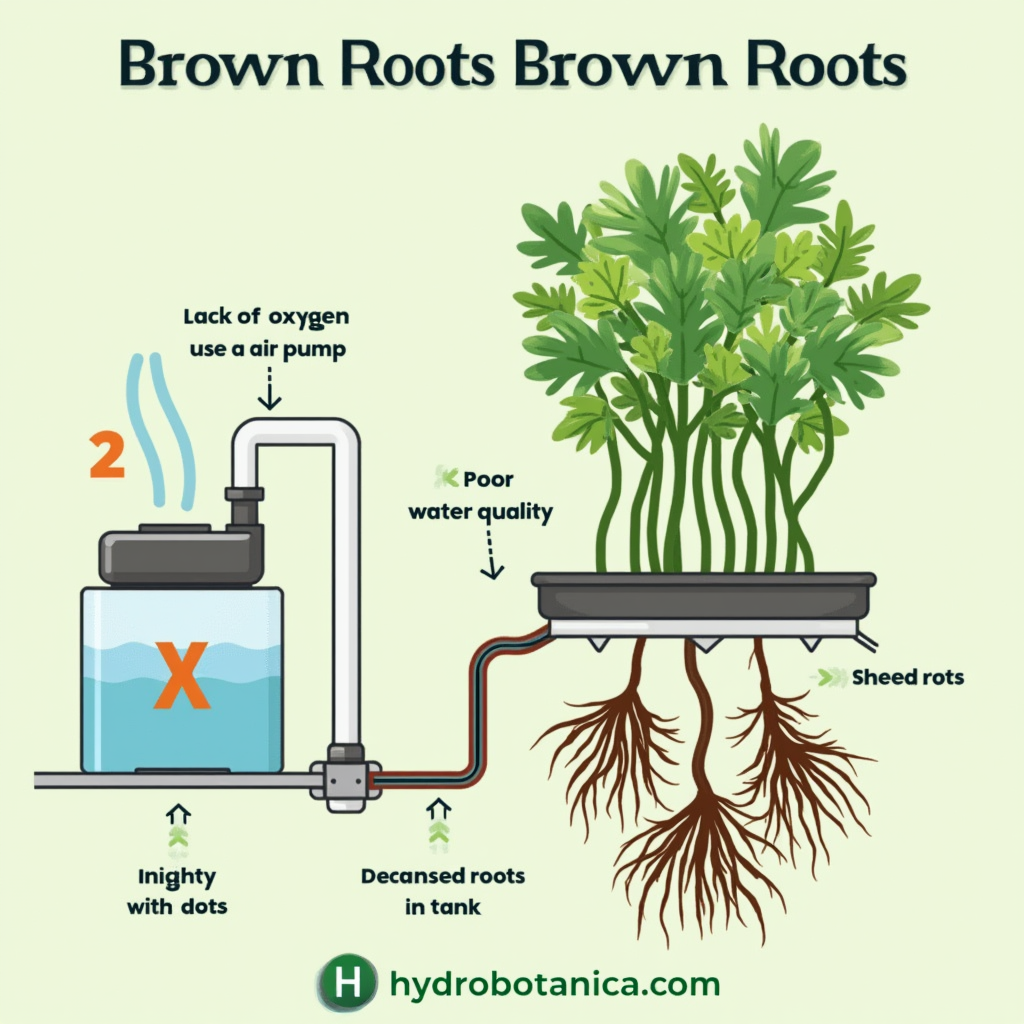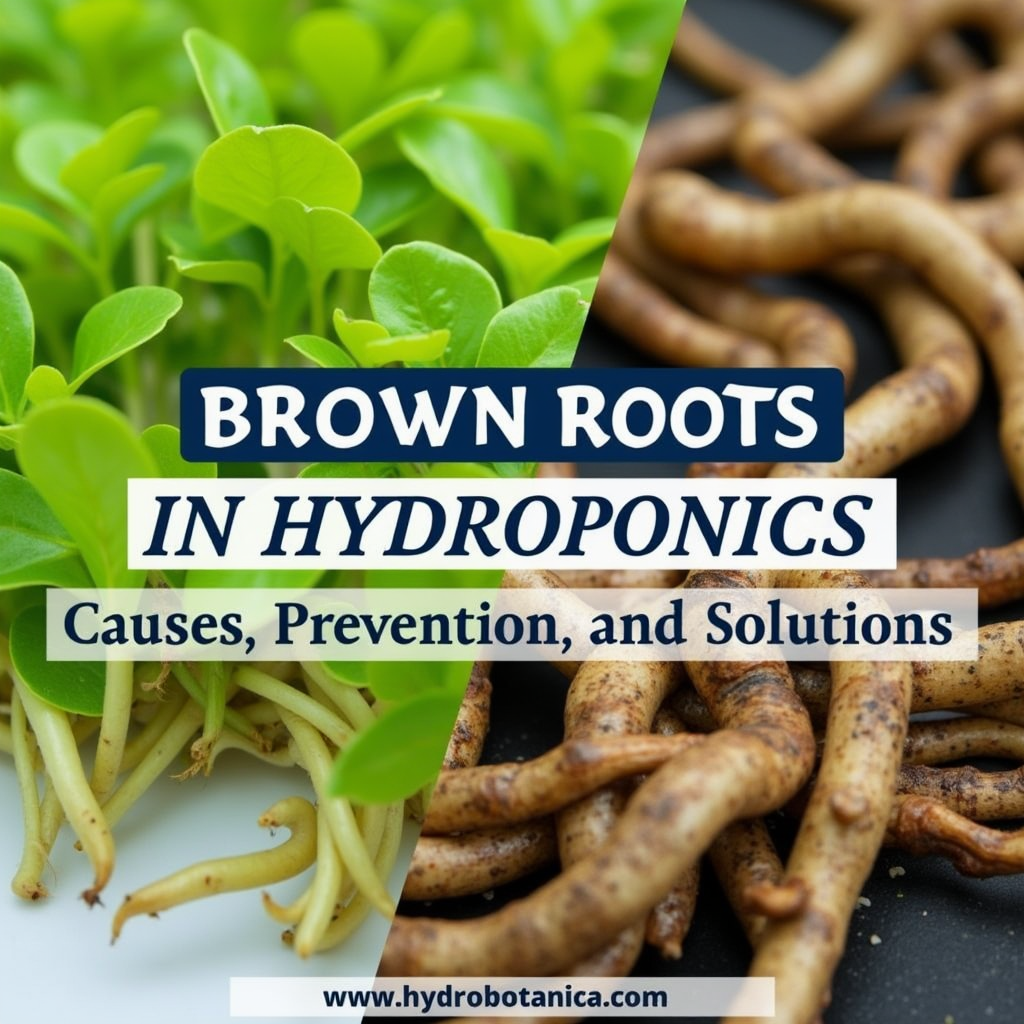In hydroponic gardening, root health is everything. If your plants’ roots are turning brown, it’s a sign that something is wrong. Healthy roots are the lifeline of your hydroponic system—they should be white, firm, and odorless. But when they turn brown, slimy, or mushy, it’s a red flag. This article dives into the causes of brown roots in hydroponics, actionable prevention strategies, and proven solutions to revive your plants. Whether you’re a beginner or a seasoned grower, understanding hydroponic root rot solutions will save your crops and keep your garden thriving.
What Do Brown Roots Indicate in Hydroponics?

Healthy vs. Unhealthy Roots
In a thriving hydroponic system, roots are bright white and sturdy. Brown roots in hydroponics signal stress, often caused by:
- Root rot from fungal/bacterial infections.
- Low oxygen levels (hypoxia).
- Poor water quality or nutrient imbalances.
- High water temperatures or stagnant water.
If ignored, brown roots can weaken plants, stunt growth, or even kill them. Early detection is key!
Why Root Color Matters
Roots act as the plant’s nutrient highway. Discoloration disrupts their ability to absorb water and minerals, starving your crops. For example, a tomato plant with brown roots might show yellowing leaves or drooping stems. Root discoloration is a cry for help—don’t ignore it!
What Causes Brown Roots in Hydroponic Systems?

Root Rot Due to Poor Oxygen Levels
Root rot is the #1 culprit behind root discoloration. Hydroponic roots need oxygen to breathe—without it, they suffocate and rot. Common causes:
- Overcrowded reservoirs reducing airflow.
- Malfunctioning air pumps or clogged air stones.
- Water temperatures above 75°F (24°C), which lower dissolved oxygen.
Real-World Scenario: A grower using a Deep Water Culture (DWC) system noticed slimy roots after their air pump failed. Without oxygen, roots became anaerobic, inviting Pythium (a water mold) to attack.
Fungal and Bacterial Infections
Pathogens like Pythium, Fusarium, and Rhizoctonia thrive in warm, stagnant water. Signs include slimy roots and a foul smell. These microbes spread quickly—contaminated tools or infected seedlings can introduce them to your system.
Pro Tip: Pythium is nicknamed the “root assassin” for its rapid destruction. It’s common in systems with poor sterilization practices.
Water Temperature and Stagnation
Warm water (over 75°F) accelerates pathogen growth and reduces oxygen. Stagnant water compounds the issue by creating a breeding ground for algae and microbes.
Case Study: A hydroponic lettuce farm in Arizona struggled with recurring brown roots. After installing a water chiller to maintain 68°F (20°C), root health improved by 80%.
Nutrient Imbalances and Overfeeding
Excess nutrients (like salts) burn roots, turning them brown. Imbalanced pH (below 5.5 or above 6.5) also stresses roots.
Example: Overusing bloom boosters in a flowering stage caused nutrient lockout in a pepper plant, leading to brittle, brown roots.
Prevention Tips for Healthy Hydroponic Roots
Maintain Proper Oxygen Levels
- Use air stones and pumps to keep water oxygen-rich.
- Check air stones monthly for clogs. Replace them yearly.
- For larger systems, consider venturi injectors or waterfall setups for added aeration.
Pro Tip: Dissolved oxygen (DO) meters help track levels. Aim for 6–8 ppm for most crops.
Control Water Temperature
- Keep reservoirs between 65°F–75°F (18°C–24°C).
- Use water chillers, reflective covers, or shade reservoirs in hot climates.
- Insulate reservoirs in colder environments to avoid temperature swings.
DIY Hack: Freeze water bottles and float them in the reservoir for a budget-friendly cooling solution.
Clean and Sterilize Regularly
- Clean hydroponic reservoirs weekly with hydrogen peroxide (3% solution) or bleach (1:10 ratio with water).
- Replace water every 1–2 weeks to prevent salt buildup.
- Sterilize tools, nets, and grow trays between cycles.
Step-by-Step Cleaning Guide:
- Drain the system.
- Scrub surfaces with a hydrogen peroxide mix.
- Rinse thoroughly.
- Refill with fresh, pH-balanced water.
Use Beneficial Bacteria
Add root-friendly microbes like Bacillus amyloliquefaciens (e.g., Hydroguard) to outcompete pathogens. These “good bacteria” form a protective biofilm around roots.
Science Spotlight: Beneficial microbes also break down dead root matter, reducing sludge in the reservoir.
How to Fix Brown Roots in Hydroponic Systems
Step 1: Isolate Affected Plants
Remove plants with brown roots to prevent spreading. Quarantine them in a separate system or discard severely infected plants.
Step 2: Flush the System
- Drain and scrub the reservoir with hydrogen peroxide.
- Refill with pH-balanced water (5.8–6.3) and half-strength nutrients.
Pro Tip: Use reverse osmosis (RO) water to eliminate contaminants during recovery.
Step 3: Apply Treatment
- Hydrogen Peroxide Soak: Mix 1 tsp of 3% H₂O₂ per gallon of water. Soak roots for 30 minutes to kill pathogens.
- Commercial Treatments: Products like Great White (mycorrhizae) or Southern AG Garden Friendly Fungicide boost root immunity.
Warning: Avoid undiluted hydrogen peroxide—it can harm roots!
Step 4: Restore Oxygen and Monitor
Reinstall air stones and check daily for improvements. Trim dead roots with sterilized scissors.
Recovery Timeline:
- Days 1–3: Roots may appear darker as dead tissue sloughs off.
- Days 4–7: New white roots emerge if conditions improve.
Ensuring Long-Term Root Health in Hydroponics
Monitor Dissolved Oxygen Levels
Invest in a DO meter. For leafy greens, 6 ppm suffices; fruiting plants (e.g., tomatoes) need 8 ppm.
Tool Recommendation: The Bluelab PENDO Meter offers precise DO readings.
Use Root-Zone Supplements
- Silica Supplements: Strengthen cell walls against pathogens.
- Seaweed Extracts: Stimulate root growth with natural hormones.
- Enzymes: Cannazym or Hygrozyme break down dead roots, keeping reservoirs clean.
Schedule Regular Maintenance
- Daily: Check pH and EC (electrical conductivity).
- Weekly: Inspect roots and clean reservoirs.
- Monthly: Replace air stones and test pumps.
Checklist for Success:
- pH: 5.8–6.3
- EC: 1.2–2.5 mS/cm (varies by crop)
- Water temp: 65°F–75°F
- DO: 6–8 ppm
Conclusion
Brown roots in hydroponics don’t have to mean disaster. With quick action—like flushing systems, boosting oxygen, and using treatments—your plants can recover. Remember: Prevention is easier than cure! Keep water cool, clean, and oxygenated, and your hydroponic garden will thrive.
FAQ
Q: What are the main causes of brown roots in hydroponics?
A: Root rot, poor oxygenation, high water temps, nutrient imbalances, and pathogens like Pythium.
Q: Can brown roots recover?
A: Yes—trim dead parts, treat with H₂O₂, and improve growing conditions. New roots often regrow in 1–2 weeks.
Q: How does water quality affect root health?
A: Stagnant or warm water breeds pathogens; balanced pH and EC prevent stress. Use RO water for purity.
Q: How often should I clean my hydroponic system?
A: Full cleans every 1–2 weeks, with daily pH/EC checks.
Q: Are organic treatments effective against root rot?
A: Yes! Beneficial bacteria (e.g., Hydroguard) and cinnamon (natural antifungal) work well.






Nestor M. Non
February 1, 2025 — 10:32 pm
Very informative, thanks for sharing